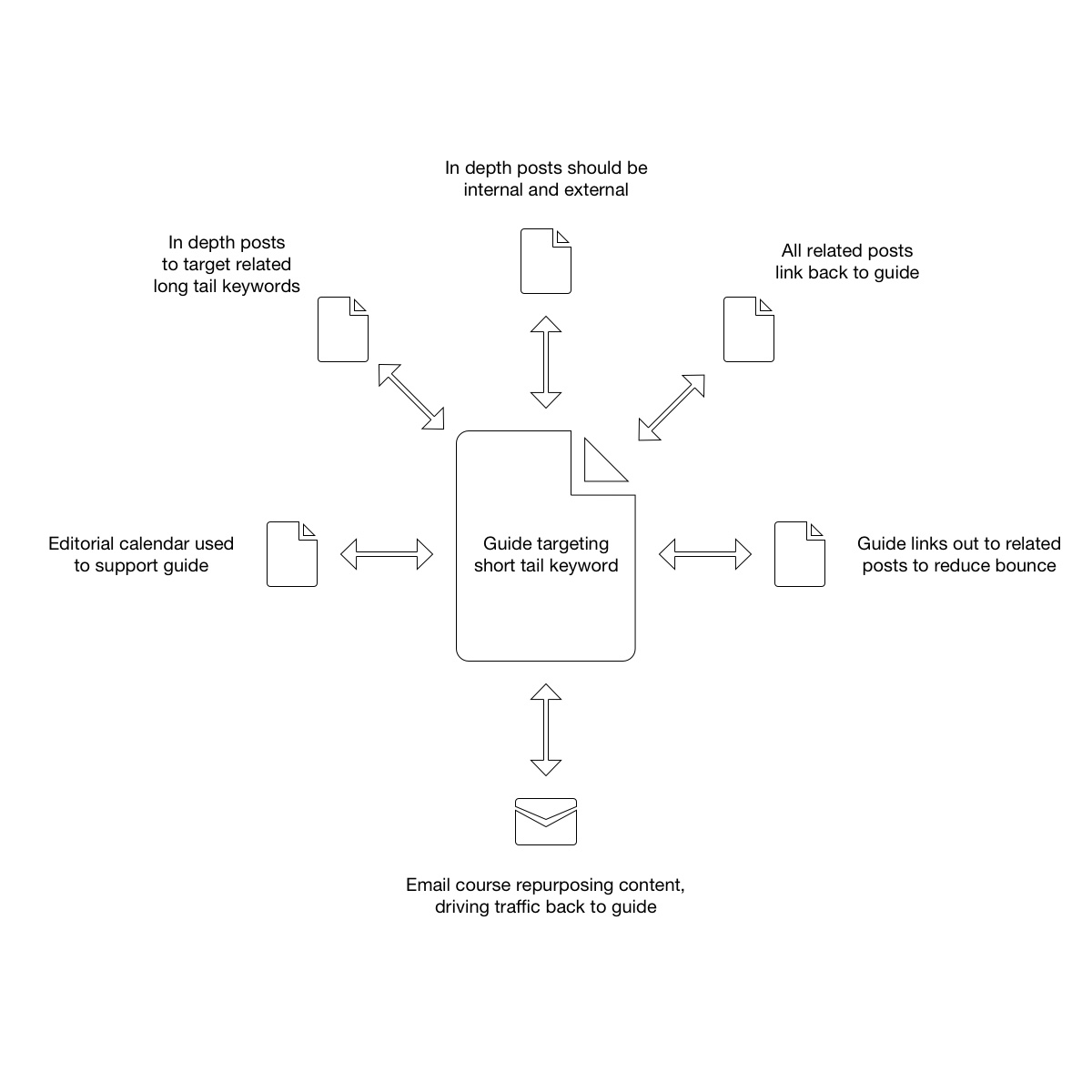Creating a successful content strategy can be challenging. But, a Hub and Spoke Content Strategy might just be the answer.
This strategy involves creating a central “hub” of content, which is then supported by related “spoke” pieces. The hub is a comprehensive guide or resource on a main topic. The spokes are smaller, related articles or posts that link back to the hub.
This method helps organize your content, making it easier for readers to navigate. It also boosts your SEO by increasing internal links and keyword relevance. By using this strategy, you can keep your audience engaged and improve your content’s reach. Ready to learn more about how this works? Let’s dive in!
Introduction To Hub And Spoke
The Hub and Spoke content strategy is a structured way of organizing content. Think of a bicycle wheel. The hub represents the central piece of content. The spokes are related, supporting pieces that link back to the hub. This method helps create a strong, interconnected content network.
Concept Overview
The hub is a comprehensive piece of content. It covers a broad topic in detail. Spokes are subtopics. They dive deeper into specific aspects of the hub topic. Each spoke links back to the hub. This creates a web of related content. This structure helps users find all related information easily.
Importance In Seo
The Hub and Spoke strategy plays a key role in SEO. It helps search engines understand content structure. They see the main topic and its subtopics. This improves content relevance and ranking. It also boosts site authority.
Interlinking content helps distribute link equity. This means each piece supports others. More links lead to better search engine visibility. It also improves user experience. Users stay on your site longer. They find related content easily.
In short, Hub and Spoke is vital for a strong content strategy. It enhances SEO, user engagement, and site authority.
Building The Hub
The Hub and Spoke Content Strategy is a powerful way to organize and optimize your content. The first step is building the hub. This involves creating core content that serves as the foundation for related topics. Let’s explore the key steps involved.
Core Content Creation
Start by creating comprehensive and informative content that covers the main subject. This content should be detailed, well-researched, and address the primary needs of your audience.
- Ensure the content is easy to understand.
- Use short sentences and simple language.
- Incorporate visuals like images or infographics.
Consider these elements when crafting your core content:
| Element | Description |
|---|---|
| Title | Make it clear and relevant. |
| Introduction | Engage the reader from the start. |
| Body | Provide valuable information and insights. |
| Conclusion | Summarize key points and suggest next steps. |
Choosing Pillar Topics
Pillar topics are broad themes that relate to your core content. These topics should be relevant to your audience and align with your main subject.
- Identify common questions or problems.
- Choose topics with high search volume.
- Ensure topics are relevant to your core content.
Here are some tips for selecting pillar topics:
- Research keywords related to your core content.
- Analyze competitors to find gaps.
- Use tools like Google Trends for insights.
By carefully selecting pillar topics, you can create a strong hub that supports your overall content strategy.
Developing Spoke Content
Developing spoke content is a key part of the hub and spoke content strategy. Each spoke supports the main hub content. This helps to improve search engine visibility and user engagement. Let’s dive into how to create effective spoke content.
Supporting Articles
Supporting articles play a vital role in your content strategy. These articles should cover related topics that link back to your main hub. They provide additional value and context to your main content. Here are some tips for creating supporting articles:
- Identify related topics that complement your main hub content.
- Ensure each article addresses a specific subtopic or question.
- Use clear and concise language to make articles easy to read.
- Include visuals such as images, infographics, or videos to enhance understanding.
- Optimize each article for specific keywords to boost SEO.
Linking Strategies
Linking strategies are crucial for connecting your spoke content to the hub. Proper linking helps search engines understand the relationship between your content pieces. It also guides users through your content journey. Here are some effective linking strategies:
- Internal Links: Include links within your spoke articles that point back to the hub content.
- Anchor Text: Use relevant keywords as anchor text for your links to improve SEO.
- Contextual Links: Place links within the context of the content, making them natural and helpful.
- Navigation Links: Add links to your hub and spoke content in your website’s navigation menu.
- Related Articles: At the end of each spoke article, suggest other related articles for further reading.
By following these strategies, you can create a strong web of content. This will enhance both user experience and search engine rankings.
Keyword Research
Keyword research is the foundation of a successful Hub and Spoke content strategy. By identifying the right keywords, you can create content that attracts the right audience. This helps you rank higher on search engines and drive organic traffic to your site.
Identifying Core Keywords
Start by identifying core keywords related to your main topic. These are broad terms that describe the essence of your content. Use tools like Google Keyword Planner or Ahrefs. Look for high search volume and low competition.
Core keywords should be relevant to your audience. They need to reflect what your audience is searching for. Create a list of these keywords. This will serve as the foundation of your content strategy.
Long-tail Keywords
Long-tail keywords are more specific phrases. They often consist of three or more words. These keywords have lower search volumes but higher intent. Users searching for long-tail keywords know what they want.
Use tools like Ubersuggest or SEMrush. Identify long-tail keywords that relate to your core keywords. Include these in your content to attract niche audiences. They can help you rank for specific searches and drive targeted traffic.
Long-tail keywords also help in answering specific questions. They can improve your chances of appearing in featured snippets. This enhances your visibility and authority in your niche.
Content Planning
Content planning is crucial for a successful hub and spoke content strategy. It ensures that all content aligns with your main topics and goals. Through proper planning, you can create valuable and engaging content for your audience. Let’s explore the key aspects of content planning.
Editorial Calendar
An editorial calendar helps you organize your content schedule. It allows you to plan posts in advance and maintain consistency. You can list out topics, assign deadlines, and track progress. This ensures a steady flow of content that aligns with your hub topics.
Content Mapping
Content mapping involves organizing your content around your hub topics. This means creating related pieces that support and expand on your main topics. By mapping out your content, you can ensure each piece is relevant and valuable. It helps your audience find related information easily.

Credit: contentmarketinginstitute.com
Internal Linking
Internal linking is crucial for a successful hub and spoke content strategy. It connects related content within your website. This improves navigation and enhances user experience. Internal linking also helps search engines understand your site’s structure. Let’s dive into some best practices and SEO benefits of internal linking.
Best Practices
Use descriptive anchor text for links. This helps users and search engines understand the linked content. Ensure the anchor text is relevant to the content it links to. Avoid using generic phrases like “click here” or “read more.”
Link to relevant content within your website. This keeps users engaged and reduces bounce rates. Make sure each link adds value to the reader.
Keep your links natural and contextually relevant. Too many links can overwhelm readers. Focus on quality over quantity.
Ensure your linked content is up-to-date. Outdated content can harm your credibility. Regularly review and update your internal links.
Seo Benefits
Internal linking helps search engines crawl your site more efficiently. This can improve your site’s indexing. Links create a clear path for search engines to follow.
Internal links distribute page authority across your site. This can boost the ranking of less visible pages. High-authority pages can pass some of their value to other pages.
Links help users find related content, improving dwell time. Longer dwell times can signal to search engines that your content is valuable.
Internal linking supports keyword strategy. Linking related content with targeted keywords can improve relevance. This can enhance your site’s overall SEO performance.
Promotion Strategies
Promotion strategies are vital for the success of a hub and spoke content strategy. They ensure your content reaches the right audience. Effective promotion can increase engagement and drive traffic to your site. Let’s explore some key promotion strategies.
Social Media Integration
Social media is a powerful tool for promoting your content. Share your content across various platforms. Tailor each post to fit the platform’s style. Use engaging headlines and visuals to attract attention. Tag relevant influencers and use trending topics. This can help your content reach a wider audience.
Encourage your followers to share your posts. This increases visibility and can attract new followers. Respond to comments and messages promptly. This builds a strong connection with your audience. Consistent engagement can lead to loyal followers.
Outreach Techniques
Outreach is crucial for expanding your content’s reach. Connect with influencers in your niche. They have established audiences that trust their recommendations. Offer them value in return for promoting your content. This can be through guest posts or exclusive insights.
Identify relevant websites and blogs. Reach out to them with personalized messages. Share why your content would benefit their audience. Building relationships can lead to long-term collaboration. This can significantly boost your content’s reach.

Credit: www.jimmydaly.com
Measuring Success
Understanding the effectiveness of your Hub and Spoke content strategy is crucial. Measuring success helps you see what works and what needs improvement. Tracking key metrics and using analytics tools provide insights to optimize your strategy.
Key Metrics
To measure success, focus on several key metrics. These metrics help you understand how your content performs. They include:
- Traffic: The number of visitors to your hub and spoke pages.
- Engagement: Metrics like time on page, bounce rate, and pages per session.
- Conversions: Actions taken by users, such as sign-ups or purchases.
- Backlinks: The number and quality of external sites linking to your content.
- Social Shares: The number of times your content is shared on social media.
Analytics Tools
Using the right analytics tools is essential to track your metrics effectively. Some popular tools include:
| Tool | Description |
|---|---|
| Google Analytics | Tracks website traffic and user behavior. |
| SEMrush | Analyzes backlinks, keywords, and competitor performance. |
| Ahrefs | Provides insights into backlinks and SEO metrics. |
| BuzzSumo | Monitors content performance and social shares. |
Using these tools, you can gather valuable data. This data helps refine your Hub and Spoke content strategy.
Common Mistakes
Implementing a Hub and Spoke content strategy can boost your SEO efforts. But, many content creators make common mistakes. These mistakes can affect the effectiveness of this strategy. Let’s explore these mistakes and how to avoid them.
Avoiding Duplicate Content
Duplicate content can hurt your SEO rankings. Search engines struggle to decide which version to index. This confusion can lead to lower rankings for all versions.
Consider these tips to avoid duplicate content:
- Use canonical tags to indicate the preferred version of a page.
- Create unique content for each spoke, addressing different aspects of a topic.
- Regularly check for duplicate content using tools like Copyscape or Siteliner.
Maintaining Content Quality
High-quality content is crucial for engaging readers. It also helps in ranking higher on search engines. Poor quality content can drive readers away.
Here are some ways to maintain content quality:
- Conduct thorough research before writing each spoke.
- Ensure the information is accurate, up-to-date, and valuable to readers.
- Edit and proofread content to remove errors and improve readability.
- Use a consistent tone and style across all pieces of content.
By avoiding these common mistakes, you can make your Hub and Spoke content strategy more effective. This will lead to better engagement and improved SEO rankings.
Future Trends
The Hub And Spoke Content Strategy continues to evolve. As digital landscapes change, so do the methods we use. Understanding future trends in this strategy is crucial. Let’s explore some of these trends.
Evolving Seo Practices
SEO practices are always changing. Keeping up with these changes is key. Search engines are getting smarter. They understand user intent better. This means content quality is more important than ever. Focus on creating valuable, informative content.
Also, the use of long-tail keywords is on the rise. These keywords help target specific queries. They are less competitive and more effective. Ensure your content includes these keywords naturally.
Technology Impact
Technology plays a big role in content strategy. AI and machine learning are transforming how we create and distribute content. Tools powered by AI can help in content creation. They suggest topics, keywords, and even generate drafts.
Voice search is another trend to watch. More people use voice assistants to search online. Optimize your content for voice search. Use conversational language and answer common questions directly.
Also, consider the impact of mobile technology. Ensure your content is mobile-friendly. A responsive design enhances user experience. It also boosts your SEO rankings.
By staying updated with these trends, you can keep your content strategy effective and relevant.

Credit: growthrocks.com
Frequently Asked Questions
What Is A Hub And Spoke Content Strategy?
A hub and spoke content strategy involves creating core content (hub) and supporting content (spokes). The hub is the main topic, while spokes are subtopics linking back to the hub.
Why Use A Hub And Spoke Content Strategy?
Using a hub and spoke content strategy improves SEO by organizing content logically. It enhances user experience by providing comprehensive information on a topic and improves site navigation.
How Do I Create A Hub And Spoke Content Strategy?
To create a hub and spoke strategy, start with a core topic (hub). Then, develop related subtopics (spokes) that link back to the hub. Ensure all content is high-quality and relevant.
What Are The Benefits Of This Content Strategy?
The benefits include improved SEO, better user engagement, and higher site authority. It helps in creating a structured content plan and increases the chances of ranking higher in search engine results.
Conclusion
Adopting a hub and spoke content strategy can boost your website’s performance. It helps organize content, making it easier for users to navigate. This strategy also improves your SEO, driving more traffic to your site. Focus on creating valuable content for your audience.
Consistency is key. Regular updates keep your content fresh and relevant. Remember, the goal is to provide useful information. Engage your readers with clear and concise writing. Your audience will appreciate the effort. Keep refining your approach for the best results.
Happy writing!

I am a passionate digital marketer with a strong expertise in SEO and article writing. With years of experience in crafting compelling content and optimizing it for search engines, I help businesses enhance their online visibility and drive organic traffic. Whether it’s creating engaging blog posts or implementing effective SEO strategies, I am dedicated to delivering results that make an impact.
